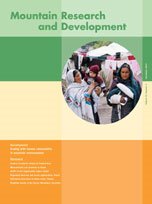Micronutrient problems in the food systems of the Himalaya are widespread due to bedrock with low nutrient content, high erosion rates, poverty, subsistence agriculture, and increasing cropping increasing cropping intensity. Agriculturally based strategies for the reduction of micronutrient malnutrition will require knowledge of the scale and spatial patterns of soil deficiencies or excesses of some elements. The present article documents current knowledge about the micronutrient status of cultivated soil in Nepal. Most studies have recorded largely the same magnitude of deficiencies in this country. Some 80 to 90% of soil samples were deficient in boron (B), 20 to 50% in zinc (Zn), and 10 to 15% in molybdenum (Mo). These are important micronutrient deficiencies because they limit agricultural production and affect human nutrition directly or indirectly.
How to translate text using browser tools
1 November 2007
A Review of Micronutrient Problems in the Cultivated Soil of Nepal
Peter Andersen
boron
micronutrients
molybdenum
Nepal
nutrition
soil
zinc





